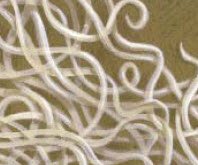Main Page Title
"Roundworms in cats, also known as “ascridoids” are nematodes. When an infestation occurs it causes a condition called “ascarias”. There are two different species of round worms, Toxocara leoina and Toxocara cati. They can cause clinical disease in cats, especially kittens. The disease may be fatal if it goes untreated in kittens. Round worms are transmitted either by an intermediate host, i.e. small rodents or directly from the feces of infected cats. Mild infestations of round worms usually go unnoticed. Initial symptoms may include having a rough, dull coat, digestive disorders and the abdomen (belly) taking on the appearance of a “pot”. In severe cases, either diarrhea or constipation occurs with vomiting. Some cats may show signs of anemia as well. Feces should be examined for the presence of roundworm eggs, during a clinical examination of affected cats. Treatment may be done by using broad-spectrum antihelmintics."
Types of Round Worms in Cats:
Two different species, T. leoina and T. cati can infest domesticated and wild cats. These cat worms are white to pink in color with a cylindrical shape. Adult worms range from 15–35 cm in length.
Cats may ingest round eggs either by ingesting a rodent which is infested with roundworms (known as a carrier), or directly if they eat contaminated food or come in contact with the feces of an infected cat. Once eggs are ingested, larva then hatch and penetrate into the outer lining of the intestines. The larva may be transmitted to other parts of the body via the blood stream. In pregnant queens, the hatched larvae can cross through the placenta, infesting embryos. They can also flow through the mammary glands, thus infesting kittens through the milk.
The larvae develops into an adult, capable of laying round worm eggs. A female may lay more than 8000 eggs a day; which are passed through the feces, thus repeating the roundworm life cycle.
Pictures of Roundworms
Signs and Symptoms of Round Worms in Cats:
In cats, mild infestations of round worms usually go unnoticed. Kittens are more susceptible to them, since they may be infested in many ways; including maternal routes of transmission i.e. either by placenta or milk.
In mild cases, Cats with roundworms appear to have a dull rough coat with no other symptoms. In severe conditions, vomiting occurs with either constipation or diarrhea, with progressive anemia. The belly appears as a pot, and becomes protruded downwards. A high population of round worms may cause weight loss and a generalized loss of body condition.
Roundworms in cats may cause death, and necropsy (autopsy) usually reveals the involvement of the kidney and the liver.
Diagnosis of Roundworms in Cats
On clinical suspicion, feces of affected cats must be examined for roundworm eggs. Eggs either appear as oval, smooth shelled or pitted, spherical shaped; egg shape differentiates between the two species of round worms which effect cats.
Treatment of Round Worms in Cats:
Different Anti–Helmintics (worming medications) like Dichlorvos (11mg/Kg B.W Per Oral), Fenbendazole (50–100 mg/Kg B.W for 3 Days), Flubendazole (20 mg/Kg B.W for 2 Days) or injection of Praziquantel (5–6 mg/Kg B.W SC or IM) can be used.
The anti–parasitic drug Selamectin can be used for treating roundworms in cats effectively as a preventive measure.
Prevention of Round Worms in Cats:
Kittens should be dewormed at an early age. Preventive doses of Anti–Helmintics should be administered in combination with Selamectin. Veterinarians must prescribe the exact preventive dose for the subject cats, as it may vary for different cats, depending upon its age, breed and sex.
Roundworm eggs may spread through contamination, dust, contact and food, so strict hygienic measures, should be taken. Avoid areas that could be contaminated such as outdoor areas visited by other cats or dogs. Keep the yard area free of any feces. Cats should be trained not to prey on small rodents and other animals including a cat to the indoors only.
There is also a homeopathic product available called Parasite Dr. which helps a cat naturally expel parasites such as roundworms. The product works by using natural ingredients such as Wormwood and Neem, which have properties which can help provide an added level of support.
Prevention of Roundworms in People
Roundworms in cats are what is known as a zoonotic disease, meaning it can be passed from pets to children and adults. This can be avoided by using a worm preventative and avoiding contaminated areas such as unprotected sandboxes.
When roundworms enter the body they travel through the lungs, liver and organs. In most people worms cause no damage, however they can get lodged in an eye or nerves. Other symptoms include abdominal pain or trouble breathing.
References:
The Merck/Merial Manual for Pet Health
A. Zajac., AAVP, ET all. Veterinary Clinical Parasitology (Wiley Blackwell. 2006)

